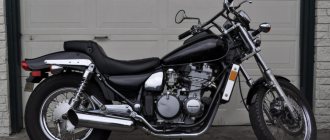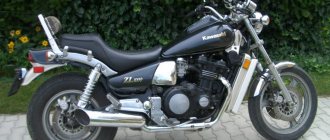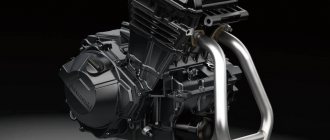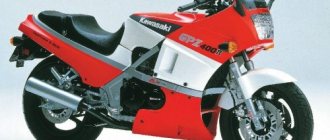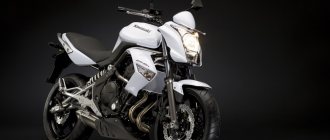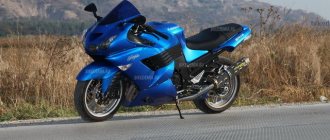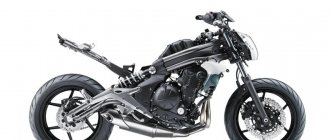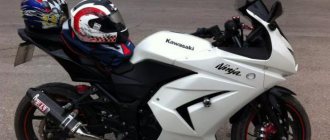This motorcycle has several versions, including a sports version. So this model may be suitable for connoisseurs of bikes of various classes (sports and cruisers). However, at its core, the car is a cruiser, but not a sports motorcycle. It’s just that the sports version of the Kawasaki ZL 400 Eliminator has a different color, design and alloy wheels.
As for the classic cruiser version, it is quite common for this kind of motorcycle. In particular, spoked wheels seem common. This motorcycle has long been a thing of the past, but the memory of it is still alive today.
Specifications
Among the positive features of this machine, of course, are its technical features. The excellent transmission and engine, combined with the appropriate chassis, cope perfectly with high speeds, difficult road conditions and the weight of the rider. At the same time, the motorcycle maintains excellent handling even at high speeds.
Thanks to a very spacious gas tank (12 liters) and relatively low fuel consumption of 5.5 liters per 100 kilometers, the motorcycle is relatively economical. However, we must admit that there are much more economical models. But what can you do, a bike cannot be both super economical and super cool in terms of technological parameters at the same time.
Review of the Kawasaki ZL 400 Eliminator (SE, LX) motorcycle
The motorcycle, due to its low weight and low center of gravity, is very easy to control and amazingly maneuverable in traffic jams. If you have good tires, you can take turns with your footpegs touching the asphalt. For the driver, the motorcycle is convenient and comfortable at a height of 190 cm. Passengers don't complain.
At speeds above 140 you have to bend down, the fairing practically does not help. Also, at high speeds, due to its low mass, the motorcycle “bounces” along the road, it flies up on every more or less large bump. You can get used to it quickly, but the sensations remain strange (fascinating).
The ZL 400 is great for long trips, but if you are traveling alone. And we must not forget that the permitted payload is 120 kilograms.
In general, frankly speaking, the motorcycle does not have enough torque. At the beginning there is a smooth acceleration, and “pickup” begins at 8-9 thousand revolutions. The jerk in second gear is especially noticeable. In general, the motorcycle is calm, although the tachometer markings reach 15,000 rpm. The presence of a cardan probably has an effect, but this is rather a plus of the motorcycle, since the cardan requires virtually no maintenance (oil change every 60,000 km).
Landing - road, back straight, knees at right angles. For me personally (height 179 cm) it is ideal. The first time I sat on its step-seat half a year ago, I realized that it felt like my own; I didn’t even have to fidget in search of the most comfortable position. I still remain with this opinion. The steering wheel is classic (other trim levels had a completely straight drag bar).
There is practically no plastic, this is a cruiser after all) 2 small covers on each side + fenders. Wind protection, of course, is not particularly developed, but up to 110 it certainly doesn’t bother me, I don’t go faster yet.
Dynamics (due to the non-standard configuration of the engine, this fully applies only to my Lum and should differ from normal ZL600, and even more so from ZL400) - awesome. The closest relative in terms of engine is one of the best sports of its time - Ninja (GPZ600), so if twist - the ride will not be boring and hardly anyone will turn their tongue at calling it a vegetable. 0-100 picks up in less than 5 seconds, with the 400m switch it starts to deflate at 120, with the 600m switch at 140 I still felt some reserve under the handle.
relative in terms of engine is one of the best sports of its time - Ninja (GPZ600), so if twist - the ride will not be boring and hardly anyone will turn their tongue at calling it a vegetable. 0-100 picks up in less than 5 seconds, with the 400m switch it starts to deflate at 120, with the 600m switch at 140 I still felt some reserve under the handle.
The gearbox is 6-speed, the shift pattern is standard, there is protection against engaging gears higher than 1st while standing still. No movement - only neutral or 1st. The first one turns on quite loudly. No flying transmissions or other nasty things. Gears are switched, neutral is caught without problems, there were no false neutrals caught. The first 2 gears are short, in 1st the acceleration ends at 20 km/h. This is a normal box in general.
Cardan - for me, it's great. There is no need to wash and lubricate something every n-kilometers, and when it rains, this happens even more often. It is enough to change 200 ml of oil every 6 thousand kilometers. A side effect is that if the piston is in good working order with good compression indicators, it is almost impossible to start it “from the pusher” alone. When 1st gear is engaged, the rear wheel is locked tightly and simply slides along the ground. To turn the crankshaft, the rear of the motorcycle must be pressed well to the ground (1 person in the passenger seat should be enough) and even better pushed; in general, I would not want to find myself in the middle of the forests alone with a dead battery).
The brakes are not the strongest point.
At the back is a drum.
I hope the new pads will revive it, while at least some slowdown begins to be felt only at the very end of the pedal stroke, although the nut on the rod is tightened almost “to the max.” At the front there are 2 discs and single-piston calipers. In combination with reinforced highways, it is generally sufficient. More productive two-piston machines from Xantus are lying and waiting in the wings, which should fall into place without altering the fasteners.
Light - well, it exists... A 35W halogen lamp in a reflector headlight does not look like a spotlight. However, you can move around at night. This season I will leave everything as it is, and in the winter I will arrange battles with the thrifty amphibian creature for additional LED light and a good LED headlight. There are examples that shine as needed and where needed, but their prices start at $300.
There is a footrest sensor, although I don’t understand the serious vital need for it. When moving forward, the footrest quite obediently folds itself. The sensor rod had completely turned sour, so I turned it to the “footrest folded” position and forgot about it. There is no central footrest. There is no fuel level sensor, which is a little inconvenient.
He's versatile. You can leisurely cruise at 60, lounging on the seat and looking around. You can lie down on the tank and anneal it, the Ninja engine allows this. He's not a showstopper like Golda in light bulbs with music or a shiny chrome Harley with a forward flow tearing apart all the hamsters in the area. The tank volume and engine appetite seem to make it not particularly suitable for long-distance driving. Its age and difficult availability of spare parts make it not particularly attractive to supporters of the “push the button - you get the result” approach.
I can recommend it to others, but I don’t really want to.
Firstly, the more popular the motorcycle, the weaker the “aura of a club of fine connoisseurs” around it :) I like it. Secondly, his age and accompanying characteristics potentially make him a source of greater trouble than younger and more common models, and I prefer not to do to others what I would not want for myself.
Change to something else? When and if 600 cubic meters becomes small. But most likely I will try to keep it. There are things you can't refuse. He's one of those guys.
A fast moto, I once skated a season, there were no complaints, it handles like a big bike, even a teenager can ride! On the contrary, I didn’t like the look of a chopper or a road worker, and the squealing sound was also annoying! But the tank was enough for the city, I didn’t go on the highway, it gets blown away by trucks! after that it was easy to sell through auto ru!
The first thing I want to note is the sound. This sound can hardly be confused with anything. At idle it sounds about like a V8 on modern cars, very bassy and menacing, then about like a V4 on something like a V-MAX or VFR, and after 8 thousand it fills up like a sports bike. I would never have thought that a rower could sound like that, especially since it’s very strange to hear all this while sitting on a large, comfortable sofa. Everyone else is just as surprised when you are the first to leave the traffic light with a sporty squeal. 58 hp is quite enough to leave behind many cars. (Well, or chopperasts on 400s with a V-twin, I hope they won’t beat me for this)
Next is taxiing, it steers reluctantly, it lays down in the same way, and it’s also scary, because there’s only one name for rubber, not only is there no tread, it’s also made of oak. But it drives straight ahead excellently, you can drive almost at maximum speed without experiencing any inconvenience at all. This motorcycle gives a strange feeling of confidence when compared with the Seabikha; I rode it on the highway in some tension, and at lower speeds. If on a Sibikh I was driving at a cruising speed of 100-120 and getting tired, then on an eluminator on the same road I can maintain 140-150 without straining myself or the motorcycle, which was very pleasing.
As for power, it’s comparable to liter choppers (with the exception of the ZL 1000, of course ). It didn’t give me a strong desire to rock out, but it did rev it up to the red zone a couple of times. The sensations are strange, but pleasant) Well, how strange, at first you think that it’s not going. and after 8 thousand you select a pole that is best to wrap around.
). It didn’t give me a strong desire to rock out, but it did rev it up to the red zone a couple of times. The sensations are strange, but pleasant) Well, how strange, at first you think that it’s not going. and after 8 thousand you select a pole that is best to wrap around.
Regarding consumption, I was pleasantly surprised. On a Sibikh I could easily consume 8-9 liters per 100 km. It rarely went past 6. Although it probably also depends on the riding style, the elum rarely provoked, and the seabiga almost every day, but she annealed it. I was very pleased with the fuel consumption on the highway. I went to a lake in another area and decided to measure the flow. I refueled until it was full, turned up the second odometer, then on the way back I refueled at the same gas station again until it was full, it came out to 4.4 liters, 97 km on the odometer. Despite the fact that I was not driving in economy mode, a couple of times when overtaking I hit the maximum speed (180 km/h, by the way), and in free sections I was driving about 140. By the way, it was with a passenger and not a fragile girl, but a friend, weight approximately 60kg. But I visited gas stations as often as I did on the Sibikh, because of the small tank (13 l).
During the season (well, more precisely August, September and October) nothing broke, which is not surprising. There were problems with the battery, but this was due to its age, because... I haven’t changed it since I bought it, and it was stuck at zero, but it charged up, ran back almost all the time (at the end of the season I sometimes had to start it from the pusher) and died safely. Also, because of my not very smart head, I had to remove the carburetors in order to tighten the cable xx (the engine was on suction, but the bad head thought that it had finally come to its senses after hibernation and the revolutions jumped up, having decided to reduce them, I simply unscrewed it, but it turned out to be somehow impossible to screw it back in without removing the carburetors)
Future plans for the motorcycle include selling it. I still can’t afford the maintenance of more or less large-capacity equipment, maybe in a few years, when I have a stable permanent income, I’ll be able to afford it, but for now, apparently, an ebrik or some Chinese is my panacea for the craving for two wheels.
Engine
Four-stroke and four-cylinder, the engine of the motorcycle immediately declares its capabilities. It is of in-line type, and its working volume is very small and amounts to 398 cubic centimeters. The maximum torque and power of this product is impressive!
Power at its peak at 12,000 rpm is 53 horsepower. The torque at its maximum value at 10,500 rpm is 33 newton meters. These are good figures for such an impressive machine.
Modifications: description and cost
Below are the main modifications of the Kawasaki Illuminator motorcycle and their cost.
Kawasaki ZL400 Eliminator
This is the very first factory model, since further versions since 1988 have been divided into modifications - Kawasaki Eliminator 400 SE and Kawasaki Eliminator 400 LX.
The Kawasaki ZL400 Eliminator offers excellent maneuverability. The motorcycle weighs 194 kg. A beautiful steel frame in a discreet style adorns the motorcycle, a cardan drive and a 12-liter fuel tank have made the model a classic for many years. The average cost of all modifications is $2,000.
Kawasaki ZL600 Eliminator
This model differs from the Kawasaki Eliminator 400 only in the engine. All other characteristics of the models are completely identical. The disadvantage of the Kawasaki ZL600 Eliminator is the small dimensions of the vehicle, so this vehicle is only suitable for bikers no taller than 175-180 cm in height. The bike's power is just over 60 horsepower.
Kawasaki ZL600 Eliminator
Kawasaki Eliminator Zl400 Sport Edition
The SE modification stands for Kawasaki Eliminator Zl400 Sport Edition. This motorcycle features a more stylish design and a more advanced dual front brake for better rider safety. This modification was produced only in black and was equipped with rims of the same color.
Kawasaki Eliminator Zl400 LX
The Kawasaki Eliminator 400 LX modification was designed with the desire to provide the driver with increased safety while riding, so the manufacturers installed a double brake on the front of the motorcycle. For convenience, the seat back has also been improved, which does not allow your back to become stiff during a long ride.
Dimensions and weight
In terms of its dimensions, this motorcycle is average, as dragsters usually are. It won't take up much space in the garage. Due to its relatively light weight, the motorcycle is also suitable for people who are not particularly athletic.
Greetings comrades! After the first season on the flame, which was full of new impressions and no breakdowns, despite the Chinese origin of the moto. I took it to gain initial skills, and I’m too big for my moped. I started by setting the task: Cruiser 120-140 km/h comfortable landing easy to maintain the motorcycle should drive away from the average car, because inadequate people sometimes tried to ram it on purpose with its side. The Seabihi 400s that I looked at were tired, and somehow they didn’t like it. When I was selling the 2nd car, they offered to exchange it for a Suzuki RF400, but then the offeror disappeared, but the interest in the bike remained, so I went to look at the option more closely. The motorcycle was owned by a kid who was, to put it mildly, careless about technology. When I sat there, I realized sports were not my thing. I can’t curl up like that, and leaning on the steering wheel is wrong. Actually, for these reasons I also refused the SV-400, because the landing is similar. As I understand it, sports are for skinny speed lovers, and not 100+ kg boars, although outwardly I really liked them. I didn’t like choppers, although they look very beautiful, but driving feet first is not an option for me. Just in case, I looked at the Honda Steed, the landing seemed extremely uncomfortable to me, and even as soon as I sat on the bike, oil leaked from the fork and the rear shock absorbers were pretty tired, and it didn’t start, plus 33 horses is still not enough. Then I looked at the hyzhira, it seemed normal, but my heart didn’t lie to him or something. I was in no hurry because the season was over, although I could have printed out the banner and gone, but I didn’t. While looking through the advertisements, I accidentally came across a Kawasaki eliminator, like a chopper, but not twin-wheeled, and the landing in the photo did not suggest driving feet first. I read about it on various resources, and it intrigued me extremely with its unusual concept: Chopper type Cardan Inline four, from the Cava GPZ sport, which can be twisted, unlike a twin-wheel drive. 50 horses, in contrast to scabby drags, steeds and others like them. Not far from me there was a small office that brought motorcycles from Zhapan, and there was this device. I went and sat and fell in love. I swore off buying a chopper, but then it just sat like a glove, the suspension travel turned out to be much greater than Steed’s, I didn’t “punch” it with my ass, which couldn’t help but rejoice. The incentive to buy was also the fact that the engine started up relatively easily on drying carbs and dead spark plugs at sub-zero temperatures. The motor requires care, but I really like it, so far I haven’t done anything with it except minimal actions when preserving it for the winter. And I don’t have the money for that yet, I’ll have to sell the flask, although it’s a bit of a pity, but I don’t need 2 motik, my wife is still afraid of motik, although she approves. I wasn’t able to test the dynamic characteristics for myself, I only drove it around a parking lot and then at minus temperatures and very carefully, but I really liked the sound. My hands are itching, I really want to take it on, but that’s all for now. I realize that there will be some difficulties with the salary, but I’m ready. A few photos to catch up: Give me some pluses, I’ll put the pepelats in the garage))) Whoever finished reading is a great cucumber)) The cigarette butts in the photo are not mine - the neighbor is a pig. Beaver everyone!
Chassis and brakes
The rear suspension of this heritage bike is double shock absorber. The front suspension is performed by a 41 mm telescopic fork. It would hardly have been possible to choose a better solution in terms of suspension.
The motorcycle has a medium-sized handlebar that allows you to easily control the machine at medium and high speeds. It looks quite stylish. The frame of the bike is duplex and made of excellent steel. The rear brakes are a drum, while the front brakes are a single disc (in the sports version, 2 discs were used).
Design features of Kawasaki Eliminator
The Kawasaki Illuminator 400 model first appeared in 1984, and its production ceased in 1994.
Stylish design and history of motorcycle changes
The main feature of the cruiser is its smooth, classic shape, as well as the 15-inch rear wheel. Initially, the series was conceived as a sports series, so engines for the models were used from sports series.
Smooth classic shapes are considered the main feature of the cruiser
The Kawasaki Illuminator line is represented by three models with a 400 cc engine:
- "Kawasaki Eliminator 400". Standard model.
- "Kawasaki Eliminator 400 SE". Model with double front brake and cast wheels.
- "Kawasaki Eliminator 400 LX". Luxury model with a comfortable seat back and dual front brakes.
The disadvantages of the Kawasaki Eliminator 400 are that it will not be possible to find new motorcycle models, since the production of this motorcycle has already ended.
Size and weight
Manufacturers have thought through all the little details, so the model is light in weight. This allows you to pick up speed faster and enjoy the ride. The motorcycle is medium in size, so it will easily fit in the owner’s garage and is suitable for riding by a person with any equipment.
